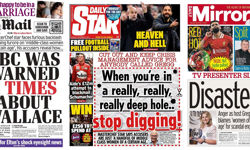The numbers are 155, 5, 12, 10, 200 million and 2, although it has to be admitted that the precise meaning of all the numbers has yet to be fully worked out and incorporated into a single algorithm that might come out with a simple, explicable answer.
So although we are not quite at the stage of having a mathematical answer to almost everything, if you break down the chain of numbers into their constituent parts – which signify different things - we are well on the way to a surprising new degree of clarity on many of the dilemmas facing newspaper publishers.
Mind the gap
The most important subset of numbers are 155 and 5. They refer to £155, the worth of an average reader to a paid-for newspaper a year in 2008. It breaks down to £90 a year from purchase price and £65 from advertising. Annual revenue from newspaper online totals just £5.
Averages can disguise great internal differences between titles but the disparity between £155 and £5 goes well beyond statistical significance. It speaks of an unimaginably unbridgeable gap between the earnings of print and online.
The second set of numbers goes a long way towards explaining why the size of such a gap is unlikely to narrow anytime soon.
Twelve hours a month is the average time readers spend with their newspapers, according to official readership surveys. Ten minutes a month is the average time spent with newspaper websites according to comScore.
Again you can quibble with individual numbers but hardly with the remarkable orders of magnitude involved but of course browsers also pick up online news elsewhere across the internet.
And lest anyone thinks that buying a social networking site is the answer - after ITV’s Friends Reunited debacle which lost the broadcaster £140 million, the number of such people is probably quite small - then here again the numbers are remorseless.
Facebook, the world’s largest networking site, at least for the next year or so, has 200 million regular worldwide users but revenue of only $2 per user per year.
Enders’ analysis
Many in the newspaper industry will be familiar with some of the numbers but Claire Enders, founder of Enders Analysis, the independent media research group, brought them together with considerable impact at a recent Mediatel seminar on the future of national newspapers.
Certainly the numbers sparked an intense debate on the importance of print and whether there is any chance of turning the clock back and begin charging for online news as Rupert Murdoch, chairman of News Corporation has bravely announced.
For Enders, the numbers have a clear strategic message.
"The expectations that the online model is going to replace the print model are totally erroneous. We now know that these are not substitutes. It’s basically an extra feature one way or the other," said Enders.
Print readers showed a different level of engagement to online readers, and although the advertising yield from newspaper websites may seem alarmingly low, it’s actually quite high when compared with Facebook users, she believes.
Enders argues that only high-end publications such as the Wall Street Journal, Financial Times or New Scientist would be able to charge for their online information. The analysis directly challenges the Murdoch view of the world. In August, Murdoch pledged that he would be charging for all his news websites including the Sun and the News of the World by next summer. All the signs are that the charging experiment in the UK will begin with the launch of a new separate Sunday Times website.
However, by whatever method newspapers are financed in future, Enders is adamant about the importance of quality journalism.
"It is particularly important to have a future for high quality print publications without which there will be no repeat of the Telegraph story (on MPs expenses)," Enders warned.
This would require newspapers to reduce the capital they employ, particularly the capital tied up in printing presses.
The researcher also warned that she does not think going into video is a money-making strategy for newspapers and she does not recommend it.
The bringing together of the key numbers sparked considerable debate within the media industry following the seminar.
Tim Forrest, head of communications planning at OMD UK, circulated comments about the issue to all his staff.
"Obviously there are caveats on the research sources and accuracy but I suspect it’s there or there about," said Forrest.
Later, he told InPublishing that they were very important numbers for the media business.
"It has absolutely mirrored implications for our business. We are wrestling with the same thing – 90% of revenue is delivered in an area that is diminishing (print) and 10% needs over-investment (online) yet we are not sure what its return will be," said Forrest.
Online model broken
At the seminar, Paul Hayes, News International’s commercial managing director, admitted that the online newspaper model was broken.
"But we will figure out a way of doing it because that is what we have to do," said Hayes who certainly has no choice in the matter because of his boss Rupert Murdoch’s determination to charge "a fair price" for the company’s content.
"We believe in charging a fair price. That is a fundamental belief and that impels everything we do from here. Do we have the answer? No. Are we working towards the answer? Yes," said Hayes.
A question of engagement
Later he accepted that the gap between the relative "dwell times" on the printed paper and the online version was a good amplification of the debate over the importance of engagement.
"Twelve hours a month, that is engagement," said Hayes who added that internal NI studies of readership of the Sunday Times showed average readership time of 64 minutes spread between Sunday and Tuesday from just one edition of the paper.
The relatively low dwell time on newspaper online sites poses a considerable challenge, Hayes believes, for their creators.
The sites must be made easier to navigate, the consumer experience must be better and the content richer if charging is going to be a success.
"If we can’t improve dwell time online, then that has implications for charging," Hayes conceded in an interview.
Compelling content required
"With billions of page impressions floating around the ether, there is always enough inventory out there and therefore the next issue is not, can I create more inventory to create more advertising volume, the issue is how do I create rich media," Hayes explained.
He can give some examples of the sort of things he has in mind. The online live Ashes scoreboard produced hours of dwell time. The dwell time on the Sun’s friendly fire cockpit video was as long as the video itself.
Apart from charging, Hayes is also looking at the equivalent of running TV advertising on the online sites of the sort created by companies such as InSkin Media.
"The emphasis is not on let’s create more inventory to get more volume of small value advertising, the emphasis is on let’s create truly compelling content for the consumer that the advertiser will recognise as compelling and be prepared to pay an appropriate price for," insisted Hayes.
Can news be charged for?
Tim Brooks, managing director of Guardian Newspapers takes a different view of charging for online even though he accepts we are at "a really significant turning point in media history" and that things will not go back to where they were before the cyclical downturn.
"We will never charge for news. I can’t see that ever happening. There are two reasons for that. One is that we believe the world is a better place if people read our news and secondly, it is incredibly easy to click away to a free source from a paid source," Brooks argues.
"Obviously that free source is the BBC which is one of the finest news organisations in the world," added the Guardian executive who believes that devices like Kindle will remain "a minority sport" unlikely to get the kind of traction the iPod enjoyed with music.
Given such views, the certainty of Murdoch on charging stands out in stark contrast even though the News Corp chairman has changed his mind on the issue before. When he first bought the Wall Street Journal, Murdoch was determined to offer all its content online for free – until he looked at the numbers.
Charging for the Journal is one thing, charging for the Sun and the Sunday Times quite another as he may soon be about to find out.
As he unveiled £2 billion News Corp losses for the financial year, Murdoch said he was prepared to lead the newspaper industry towards a pay-per-view model.
"I believe that if we’re successful, we’ll be followed fast by other media," said Murdoch who added that he was prepared for the necessary litigation to ensure that News Corp stories and pictures were not copied elsewhere.
"We will be asserting our copyright at every point," insisted Murdoch who has taken many bold initiatives in his long career and succeeded more often than not.
This time round, he will have to face down some very intractable numbers particularly the £5 a year revenue from users of newspaper websites and the 10 minutes a month spent there by the average user.
It will be a challenge even for someone like Rupert Murdoch.
But you can be sure that the entire newspaper industry will be watching to see whether he can pull off the impossible one last time.










